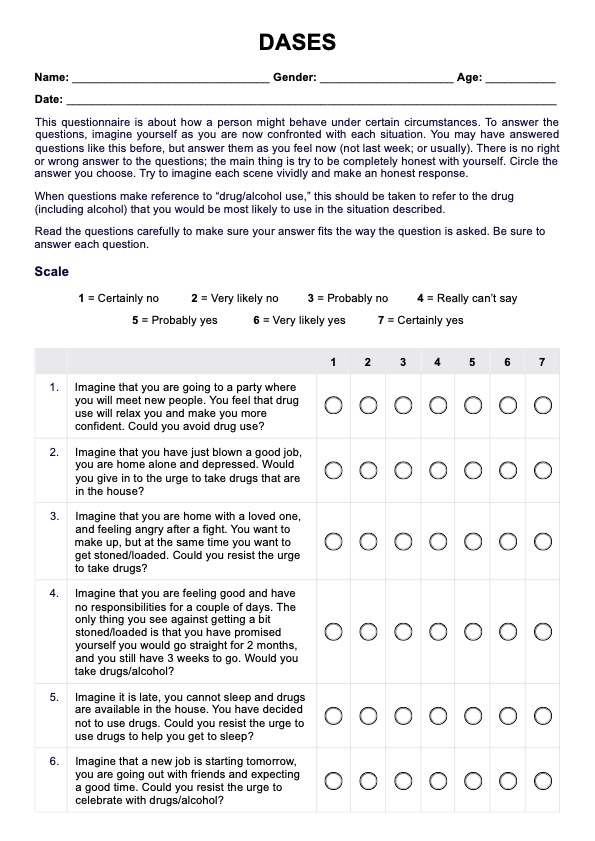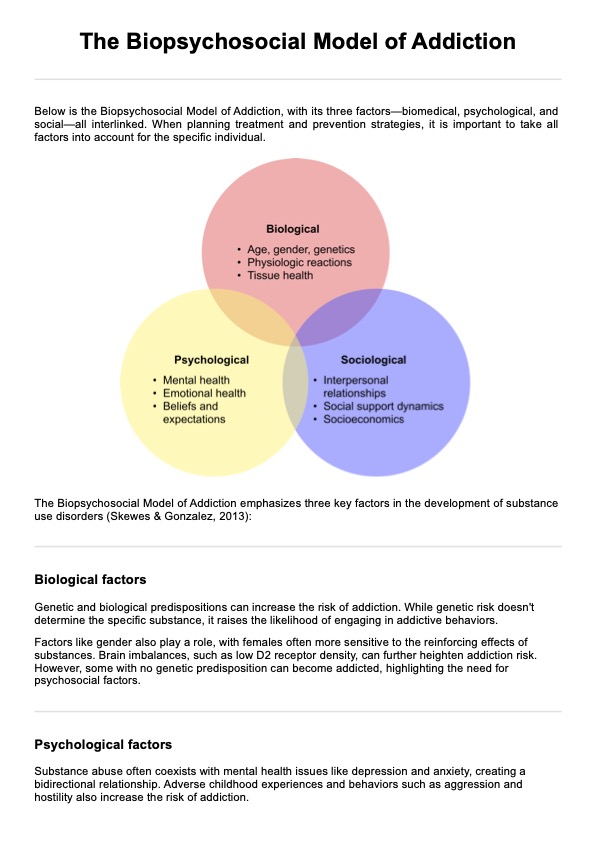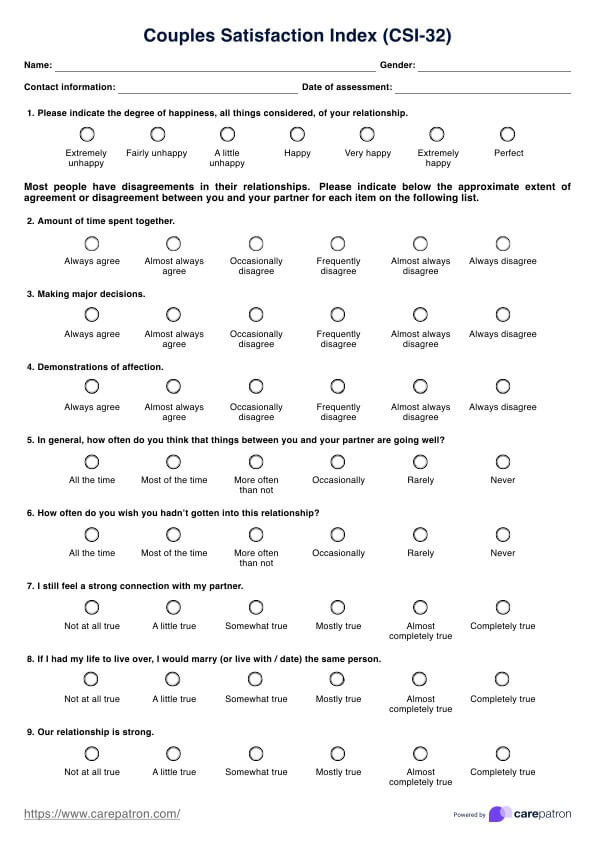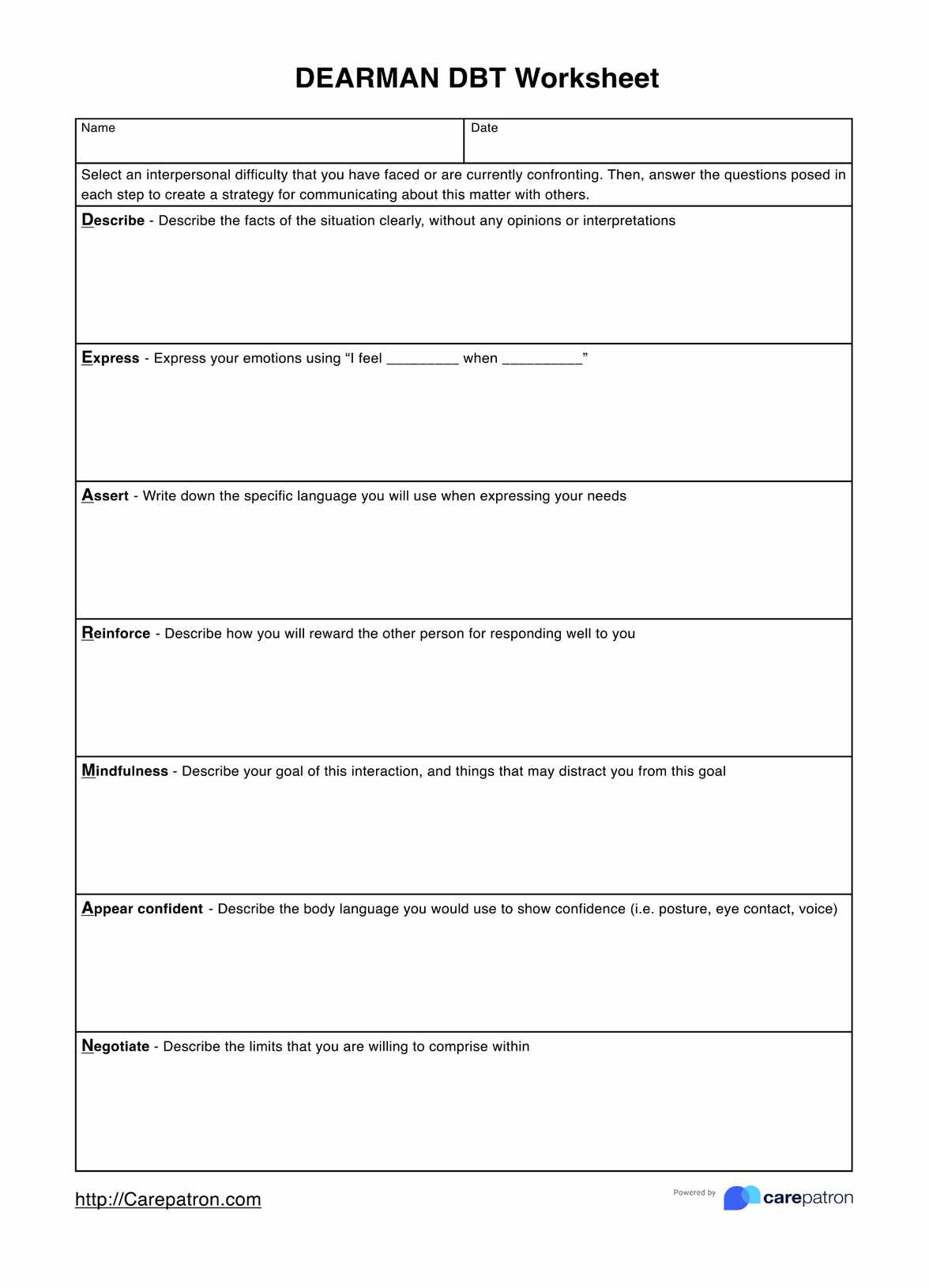CIWA-AR Scale
Use the CIWA-Ar Scale to assess the level of alcohol withdrawal in patients. It is free to download and comes with a CIWA-B Scale as an added bonus.


What is alcohol withdrawal?
Alcohol withdrawal refers to the physiological and psychological symptoms that occur when a person abruptly stops or reduces heavy and prolonged alcohol consumption. It is a challenging process, especially for individuals who have been drinking heavily for an extended period.
Understanding the severity of alcohol withdrawal underscores the importance of tools like the CIWA-Ar Scale in assessing and managing withdrawal symptoms in patients with alcohol abuse issues.
CIWA-AR Scale Template
CIWA-AR Scale Example
What is a CIWA-Ar Scale?
The Clinical Institute Withdrawal Assessment for Alcohol–Revised (CIWA-Ar) scale is a widely used tool to evaluate the severity of alcohol withdrawal symptoms. The features used for the CIWA-Ar scale encompass symptoms like nausea, headache, auditory and visual disturbances, agitation, sweating, tremors, clouding of the sensorium, and changes in orientation and anxiety levels.
The CIWA-Ar Scale allows healthcare professionals, particularly family physicians and addiction medicine specialists, to gauge the intensity of symptoms and tailor treatment accordingly. It takes into account various factors, such as the severity of hallucinations, tactile disturbances, and nervousness. The scale aims to provide an individualized treatment approach, utilizing symptom-triggered therapy and fixed schedule doses as needed.
The evidence-based practice guideline emphasizes the importance of assessing and treating alcohol withdrawal in both inpatient and outpatient settings. The severity of alcohol withdrawal is a crucial factor in determining the appropriate pharmacological management and the need for inpatient detoxification. Visual disturbances, auditory disturbances, and other symptoms are carefully considered when creating an effective management plan.
How to use the CIWA-Ar Scale
Using the Clinical Institute Withdrawal Assessment for Alcohol-Revised Scale involves a systematic evaluation of various withdrawal symptoms to assess the severity and guide appropriate treatment. Here are the general steps to use the CIWA-Ar Scale:
Step 1: Baseline assessment
Begin by obtaining a baseline measurement of vital signs, including blood pressure, pulse rate, respiratory rate, and body temperature.
Step 2: Determine the initial CIWA-Ar score
Administer the CIWA-Ar Scale questionnaire, which consists of items related to withdrawal symptoms such as nausea, sweating, tremors, anxiety, and others. Assign a score to each symptom based on the individual's reported experience.
Step 3: Score and evaluate
Tally up the scores for each symptom to calculate the total CIWA score. Based on the total score, the severity of withdrawal is categorized into mild, moderate, or severe symptoms. Depending on the severity of withdrawal symptoms, the frequency of assessment may vary. Continuous monitoring may be necessary in severe cases, while periodic assessments suffice in milder cases.
Step 4: Decide on treatment approach
The CIWA-Ar Scale assists healthcare professionals in making informed decisions about the appropriate level of care and treatment interventions. It guides the use of medications and helps determine the need for inpatient or outpatient management. In some cases, a symptom-triggered approach is employed, where medication is administered based on the specific symptoms and their severity rather than a fixed schedule.
Step 5: Reassess
Regularly reassess the individual's condition using the scale throughout the withdrawal process. Adjust treatment plans accordingly based on the evolving severity of symptoms.
Step 6: Document
Document the scores and any changes in symptoms during the withdrawal period. This documentation is valuable for tracking progress and informing further treatment decisions.
When is it best to use the CIWA-Ar Scale?
The Clinical Institute Withdrawal Assessment for Alcohol-Revised (CIWA-Ar) scale is best used in the following situations:
- Alcohol withdrawal assessment: The CIWA-Ar Scale is specifically designed for assessing and monitoring individuals undergoing alcohol withdrawal. It is most appropriate for patients with a history of alcohol dependence who are at risk of experiencing withdrawal symptoms.
- Inpatient detoxification: The scale is commonly employed in inpatient settings, especially during detoxification programs where individuals are closely monitored for alcohol withdrawal symptoms. It helps healthcare professionals determine the severity of alcohol withdrawal syndrome and guide appropriate treatment interventions.
- Symptom-triggered management: The scale is handy when employing a symptom-triggered approach to medication administration. Instead of fixed schedules, medications are administered based on the severity of specific withdrawal symptoms, as indicated by the scale.
- Continuous monitoring: In cases of severe alcohol withdrawal, the scale is valuable for constant monitoring of symptoms. This allows healthcare providers to respond promptly to changes in symptom severity and adjust treatment plans accordingly.
- Assessment for medication need: The scale is instrumental in determining the need for pharmacological interventions to manage withdrawal symptoms. It guides healthcare professionals in choosing appropriate medications and adjusting dosages based on the individual's symptomatology.
- Outpatient management: While the CIWA-Ar Scale is commonly associated with inpatient care, it can also be adapted for outpatient settings, especially when individuals are at risk of developing or experiencing mild to moderate alcohol withdrawal symptoms.
- Follow-up assessments: The scale is valuable for follow-up assessments during alcohol withdrawal treatment. It allows healthcare providers to track progress, identify any resurgence of symptoms, and make necessary adjustments to the treatment plan.
- Assessment standardization: The scale provides a standardized method for assessing alcohol withdrawal symptoms, ensuring consistency in evaluation and facilitating communication among healthcare professionals involved in the individual's care.
Overall, the CIWA-Ar aims to promote the well-being of individuals in their journey toward recovery.
What are the benefits of using the CIWA-Ar Scale?
Healthcare professionals play a vital role in the continuous assessment and treatment of alcohol withdrawal itself, considering factors like blood pressure, sweating patterns, and psychological symptoms.
Here are the key benefits one can get from this tool:
- It is easy to administer and has a standardized structure. It makes it easy for doctors to check alcohol withdrawal symptoms. It has questions about ten different symptoms, and healthcare professionals don't need special tools to use it. This helps make sure all patients get checked the same way.
- It helps healthcare professionals determine what to do for their patients. This scale allows professionals to figure out how severe a patient's withdrawal symptoms are. Doctors decide if medication is needed and how much based on the score. If a patient's score is high, they might need more medication.
- It is an excellent monitoring tool. Professionals use the CIWA-AR Scale multiple times to keep an eye on patients during detox. Symptoms can change quickly, so regular checking helps doctors adjust treatment to keep patients safe and comfortable.
Remember that the goal is to ensure a safe and comfortable withdrawal process for individuals seeking support for alcohol use.
Beyond alcohol: Assessing benzodiazepine withdrawal with the CIWA-B scale
Aside from alcohol, benzodiazepine withdrawal is also a significant concern due to its potential for severe symptoms and complications. The CIWA-Ar Scale and the Clinical Institute Withdrawal Assessment for Benzodiazepines (CIWA-B) Scale are both tools used by healthcare professionals to assess withdrawal symptoms in patients undergoing detoxification from alcohol and benzodiazepines, respectively.
While they share similarities in purpose and structure, they differ in the specific symptoms they assess and the scoring criteria used. The CIWA-Ar Scale, for instance, includes questions related to alcohol withdrawal symptoms, such as tremors and anxiety. At the same time, the CIWA-B Scale focuses on symptoms commonly associated with benzodiazepine withdrawal, such as agitation and muscle stiffness.
Commonly asked questions
Approximately 5 minutes.
The scale mentions that patients who score below 10 don’t usually need additional medication. If they score higher, you might want to provide additional medication based on the overall score and the symptoms' high rating.
No. Only professionals should use this because they will know what they need to observe while administering the scale. If you need to get checked or know someone going through alcohol withdrawal, please contact a healthcare professional.


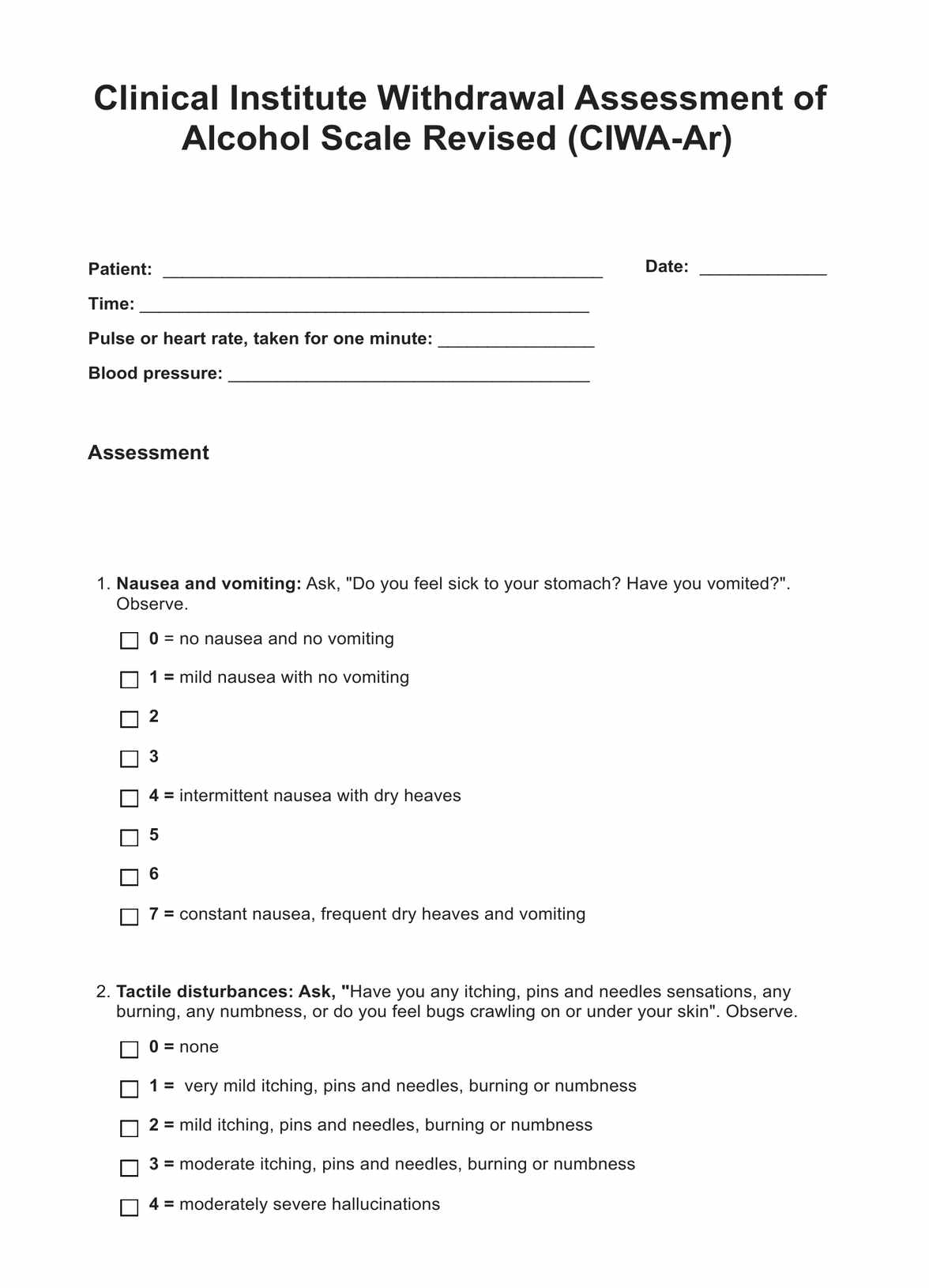
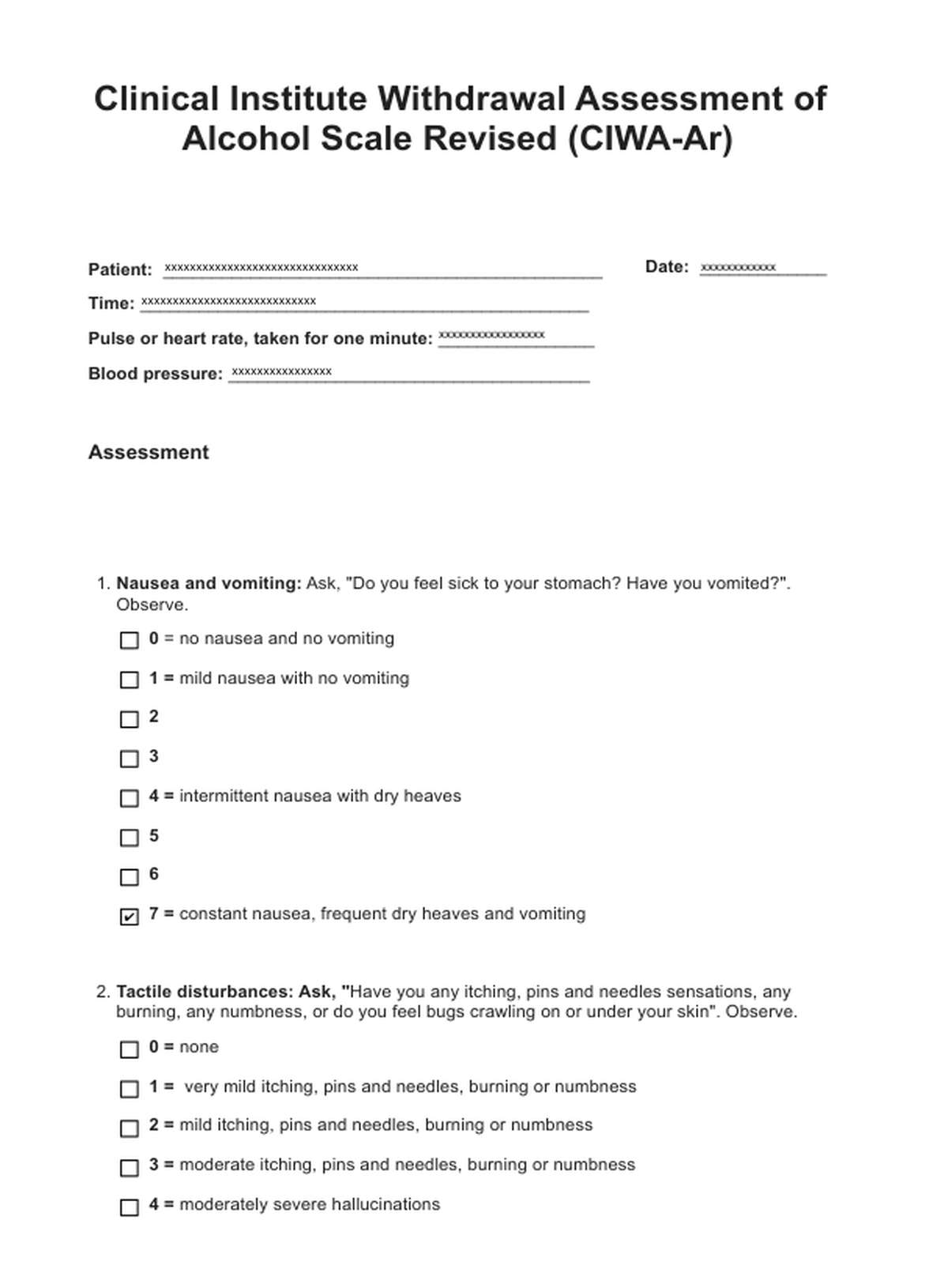


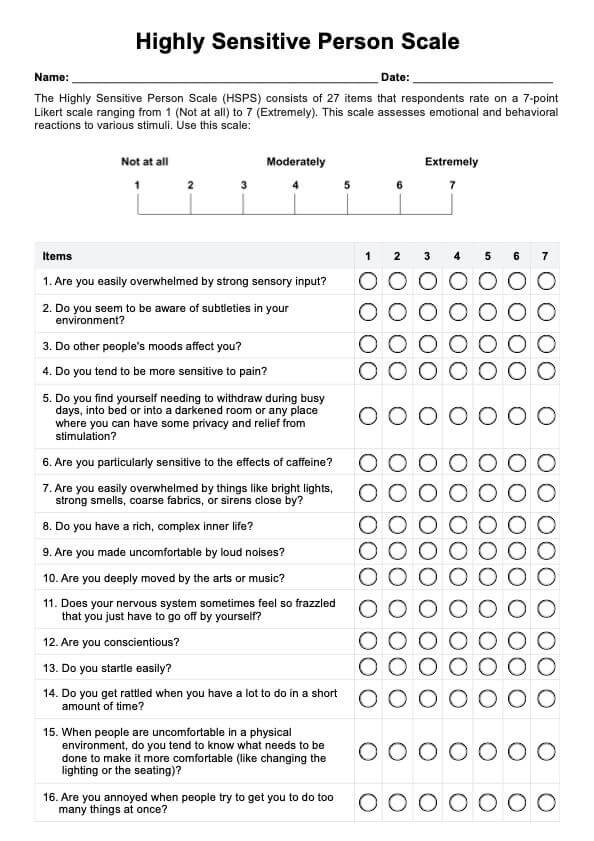










-template.jpg)


